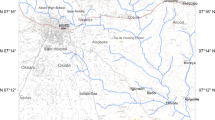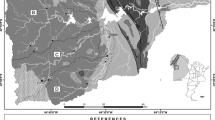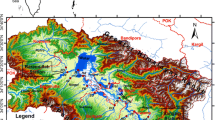Abstract
The fluvial geochemistry of the Subarnarekha River and its major tributaries has been studied on a seasonal basis in order to assess the geochemical processes that explain the water composition and estimate solute fluxes. The analytical results show the mildly acidic to alkaline nature of the Subarnarekha River water and the dominance of \(\hbox {Ca}^{2+}\) and \(\hbox {Na}^{+}\) in cationic and \(\hbox {HCO}_{3}^{-}\) and \({\hbox {Cl}}^{-}\) in anionic composition. Minimum ionic concentration during the monsoon and maximum concentration in the pre-monsoon seasons reflect concentrating effects due to decrease in the river discharge and increase in the base flow contribution during the pre-monsoon and dilution effects of atmospheric precipitation in the monsoon season. The solute acquisition processes are mainly controlled by weathering of rocks, with minor contribution from marine and anthropogenic sources. Higher contribution of alkaline earth \((\hbox {Ca}^{2+}{+}\,\hbox {Mg}^{2+})\) to the total cations \((\hbox {TZ}^{+})\) and high \((\hbox {Na}^{+}+\hbox {K}^{+})/\hbox {Cl}^{-}\), \((\hbox {Na}^{+}+\hbox {K}^{+})/\hbox {TZ}^{+}\), \(\hbox {HCO}_{3}^{-}/(\hbox {SO}_{4}^{2-}+\hbox {Cl}^{-})\) and low \((\hbox {Ca}^{2+}+\hbox {Mg}^{2+})/(\hbox {Na}^{+}+\hbox {K}^{+})\) equivalent ratios suggest that the Subarnarekha River water is under the combined influence of carbonate and silicate weathering. The river water is undersaturated with respect to dolomite and calcite during the post-monsoon and monsoon seasons and oversaturated in the pre-monsoon season. The pH–log \(\hbox {H}_{4}\hbox {SiO}_{4}\) stability diagram demonstrates that the water chemistry is in equilibrium with the kaolinite. The Subarnarekha River annually delivered \(1.477\times 10^{6}\) ton of dissolved loads to the Bay of Bengal, with an estimated chemical denudation rate of \(77\hbox { ton km}^{-2}\hbox { yr}^{-1}\). Sodium adsorption ratio, residual sodium carbonate and per cent sodium values placed the studied river water in the ‘excellent to good quality’ category and it can be safely used for irrigation.












Similar content being viewed by others
References
Abbas N and Subramanian V 1984 Erosion and sediment transport in the Ganga River basin India; J. Hydrol. 69 173–182.
APHA 1998 Standard methods for the examination of water and waste water; 20th edn, American Public Health Association, Washington DC.
Appelo C A J and Postma D 1996 Geochemistry, groundwater and pollution; AA Balkema Publication, Rotterdam.
Berner E K and Berner R A 1987 The global water cycle: Geochemistry and environment; Prentice-Hall, Englewood Cliffs, NJ.
Berner E K and Berner R A 1996 Global environmental: Water, air and geochemical cycles; Prentice-Hall, New Jersey.
Biksham G and Subramanian V 1988 Nature of solute transport in the Godavari basin, India; J. Hydrol. 103 375–392.
Binet S, Spadini L, Bertrand C, Guglielmi Y, Mudry J and Scavia C 2009 Variability of the groundwater sulfate concentration in fractured rock slopes: A tool to identify active unstable areas; Hydrol. Earth Syst. Sci. 13 2315–2327.
Brennan S K and Lowenstein T K 2002 The major ion composition of Silurian seawater; Geochim. Cosmochim. Acta 66 2683–2700.
Carbonnel J P and Meybeck M 1975 Quality variations of the Mekong River at Phnom Penh, Combodia and chemical transport in the Mekong basin; J. Hydrol. 27 249–265.
CBPCWP 1986 Assessment and development study of river basin series ADSORBS/15/1985-86. Basin sub basin inventory of water pollution: The Subarnarekha River basin; Central Board for the Prevention and Control of Water Pollution (CBPCWP), New Delhi.
Chakrapani G J and Subramanian V 1990 Preliminary studies on the geochemistry of the Mahanadi river basin, India; Chem. Geol. 81 241–243.
Chen J, Wang F, Xia X and Zhang L 2002 Major element chemistry of the Changjiang (Yangtze river); Chem. Geol. 187 231–255.
Das B K and Dhiman S C 2003 Water and sediment chemistry of higher Himalayan lakes in the Spiti valley: Control of weathering, provenance and tectonic setting of the basin; Environ. Geol. 44 717–730.
Das A, Krishnaswami S, Sarin M M and Pande K 2005 Chemical weathering in the Krishna Basin and Western Ghats of the Deccan Traps, India: Rate of basalt weathering and their controls; Geochim. Cosmochim. Acta 69 2067–2084.
Drever J I 1988 The geochemistry of natural waters; 2nd edn, Prentice-Hall, Englewood Cliffs.
Eaton F M 1950 Significance of carbonates in irrigation waters; Soil Sci. 39 123–133.
Gaillardet J, Dupre B, Allegre C J and Negrel P 1997 Chemical and physical denudation in the Amazon River Basin; Chem. Geol. 142 141–173.
Gaillardet J, Dupre B, Louvat P and Allegre C J 1999 Global silicate weathering and \(\text{ CO }_{2}\) consumption rates deduced from the chemistry of large rivers; Chem. Geol. 159 3–30.
Galy A and France-Lanord C 1999 Weathering processes in the Ganges–Brahmaputra basin and the riverine alkalinity budget; Chem. Geol. 159 31–60.
Garrels R M and Christ C L 1965 Solutions, minerals and equilibria; Harper and Row, New York.
Garrels R M and Mackenzie F T 1967 Origin of the chemical compositions of some springs and lakes; In: Equilibrium concepts in natural water systems (ed.) Stumm W, J. Am. Chem. Soc., pp 222–242.
Gibbs R J 1970 Mechanisms controlling world water chemistry; Science 17 1088–1090.
Gibbs R J 1972 Water chemistry of Amazon River; Geochim. Cosmochim. Acta 36 1061–1066.
Gupta L P and Subramanian V 1994 Environmental geochemistry of the River Gomti: A tributary of the Ganges River; Environ. Geol. 24 235–243.
Hardie L A and Eugster H P 1970 The evolution of closed-basin brines; Mineral. Soc. Am. Special Paper 3 273–290.
Hounslow A W 1995 Water quality data: Analysis and interpretation; CRC Lewis Publishers, New York, USA.
Hu Ming-Hui, Stallard R F and Edmond J M 1982 Major ion chemistry of the some large Chinese rivers; Nature 298 550–553.
Jha P K, Tiwari J, Singh U K, Kumar M and Subramanian V 2009 Chemical weathering and associated CO\(_2\) consumption in the Godavari river basin, India; Chem. Geol. 264 364–374.
Karanth K R 1989 Groundwater assessment development and management; Tata McGraw-Hill Publ, New Delhi.
Krishnaswami S and Singh S K 2005 Chemical weathering in the river basins of the Himalaya, India; Curr. Sci. 89 841–849.
Kumar R, Singh R D and Sharma K G 2005 Water resources of India; Curr. Sci. 89 794–811.
Lecomte K L, Pasquini A I and Depetris P J 2005 Mineral weathering in a semiarid mountain River: Its assessment through PHREEQC inverse modelling; Aquatic Geochem. 11 173–194.
Maharana C, Gautam S, Singh A K and Tripathi J K 2015 Major ion chemistry of the Son River, India: Weathering processes dissolve fluxes and water quality assessment; J. Earth Syst. Sci. 124 1293–1309.
Meybeck M 1987 Global chemical weathering of surficial rocks estimated from river dissolved loads; Am. J. Sci. 287 401–428.
Meybeck M 2003 Global analysis of river systems: From earth system controls to anthropogenic controls; Phil. Trans. R. Acad. Lond. B 358 1935–1955.
Nemeth A, Paolini J and Herrera R 1982 Carbon transport in the Orinoco River: The preliminary results; In: Transport of carbon and minerals in the major world rivers (ed.) Degens E T, SCOPE/UNEP Sonderband Heft 52 357–364.
Pandey K, Sarin M M, Trivedi J R, Krishnaswami S and Sharma K K 1994 The Indus River system (India–Pakistan): Major ion chemistry, uranium and strontium isotopes; Chem. Geol. 116 245–259.
Parkhurst D L and Appelo C A J 1999 User’s guide to PHREEQC (ver. 2) – A computer program for speciation, batch-reaction, one-dimensional transport, and inverse geochemical calculations; US Geol. Surv. Water Resources Investigations Report.
Pattanaik J K, Balakrishnan S, Bhutani R and Singh P 2013 Estimation of weathering rates and \(\text{ CO }_{2}\) drawdown based on solute load: Significance of granulites and gneisses dominated weathering in the Kaveri River basin, Southern India; Geochim. Cosmochim. Acta 121 611–636.
Piper A 1944 A graphical procedure in the geochemical interpretation of water analysis; Am. Geophys. Union Trans. 25 914–928.
Presley B J, Trefry J H and Shohes R F 1980 Heavy metal inputs to Mississippi delta sediments; Water. Air Soil Pollut. 13 481–494.
Rajamani V, Tripathi J K and Malviya V P 2009 Weathering of lower crustal rocks in the Kaveri River catchment southern India: Implication to sediment geochemistry; Chem. Geol. 265 410–419.
Ramanathan A L, Vaithiyanathan P, Subramanian V and Das B K 1994 Nature and transport of solute load in the Cauvery river basin, India; Wat. Res. 28 1585–1593.
Ramesh R and Subramanian V 1988 Nature of dissolved loads of the Krishna river basin, India; J. Hydrol. 103 139–155.
Rao K L 1975 India’s water wealth, its assessment, uses and projection; Orient Longman, New Delhi.
Reeder S W, Hitchon B and Levinson A A 1972 Hydrogeochemistry of the surface waters of the Mackenzie drainage basin, Canada: Factor controlling inorganic composition; Geochim. Casmochim. Acta 36 825–865.
Richey J E, Hedges J I, Devol A H, Quay P D and Victoria R 1990 Biogeochemistry of carbon in the Amazon River; Limnol. Oceanogr. 35 352–371.
Sarin M M, Krishnaswamy S, Dilli K, Somayajulu B L K and Moore W S 1989 Major ion chemistry of the Ganga–Brahmaputra river system: Weathering processes and fluxes to the Bay of Bengal; Geochim. Cosmochim. Acta 53 997–1009.
Sharma A, Singh A K and Kumar K 2012 Environmental geochemistry and quality assessment of surface and subsurface water of Mahi River basin, India; Environ. Earth Sci. 65 1231–1250.
Singh A K and Hasnain S I 1999 Environmental geochemistry of Damodar river basin – east coast of India; Environ. Geol. 37 124–136.
Singh A K, Mondal G C, Singh P K, Singh S, Singh T B and Tewary B K 2005 Hydrochemistry of reservoirs of Damodar River basin, India: Weathering processes and water quality assessment; Environ. Geol. 8 1014–1028.
Singh A K, Mondal G C, Kumar S, Singh T B, Tewary B K and Sinha A 2008 Major ion chemistry, weathering processes and water quality assessment in upper catchment of Damodar River basin, India; Environ. Geol. 54 745–758.
Stallard R F and Edmond J M 1983 Geochemistry of the Amazon: 2. The influence of the geology and weathering environment on the dissolved load; J. Geophys. Res. 88 9671–9688.
Stallard R F and Edmond J M 1987 Geochemistry of the Amazon: 3. Weathering chemistry and limits to dissolved inputs; J. Geophys. Res. 92 8293–8302.
Stott R E and Burt T P 1997 Potassium chemistry of a small upland stream following a major drought; Hydrol. Process. 11 189–201.
Stumm W and Morgan J J 1981 Aquatic chemistry; Wiley Interscience, New York.
Subramanian V 1983 Factors controlling the chemical composition of rivers of India; In: Proceedings of the Hamburg Symposium, IAHS Publ. 141 145–151.
Subramanian V 2000 Water: Quantity–quality perspective in South Asia; Kingston International Publishers, Surrey.
Taylor S R and McLennan S M 1985 The continental crust: Its composition and evolution; Blackwell, London.
Tiwari A K and Singh A K 2014 Hydrogeochemical investigation and groundwater quality assessment of Pratapgarh district, Uttar Pradesh; J. Geol. Soc. India 83 329–343.
USSL (US Salinity Laboratory) 1954 Diagnosis and improvement of saline and alkali soils; U.S. Department of Agriculture Hand Book, No. 60, p. 160.
Viers J, Dupre B, Braunj J, Freydier R, Greenberg S, Ngoupayou J N and Nkamdjou L S 2001 Evidence for non-conservative behavior of chlorine in humid tropical environments; Aquatic Geochem. 7 127–154.
Wilcox L V 1955 Classification and use of irrigation waters; US Dept. of Agricul., Cir. 969, Washington DC.
Zhang J, Haung R, Jiu M G and Zhou Q 1990 Drainage basin weathering and major element transport of two large Chinese rivers (Huanghe and Changjiang); J. Geophys. Res. 95 13277–13288.
Zhang J, Huang W W, Letolle R and Jusserand C 1995 Major element chemistry of the Huanghe (Yellow river), China – Weathering processes and chemical fluxes; J. Hydrol. 168 173–203.
Acknowledgements
Dr. Soma Giri is grateful to the Department of Science and Technology, Government of India for funding under Fast Track Young Scientist Scheme (Grant No. SR/FTP/ES-185/2010(G)). Authors are thankful to Dr. P K Singh, Director, CSIR-CIMFR for providing the laboratory and other infrastructural facilities and lab colleagues for their help during the study.
Author information
Authors and Affiliations
Corresponding author
Additional information
Corresponding editor: Partha Pratim Chakraborty
Rights and permissions
About this article
Cite this article
Singh, A.K., Giri, S. & Chaturvedi, A. Fluvial geochemistry of Subarnarekha River basin, India. J Earth Syst Sci 127, 119 (2018). https://doi.org/10.1007/s12040-018-1020-6
Received:
Revised:
Accepted:
Published:
DOI: https://doi.org/10.1007/s12040-018-1020-6




